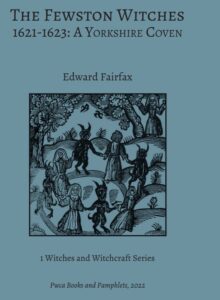The Fewston Witches: A Yorkshire Coven October 1, 2022
Author: Beach Combing | in : Modern , trackbackThe latest episode of the boggart and banshee podcast is on the Fewston Coven; see also the Pwca book of Edward Fairfax’s witch diary, the readalong for the podcast.
In 1621 a coven of six witches in Fewston (in the old West Riding of Yorkshire) decided to persecute a local family, the Fairfaxes. In one of their meetings at nearby Timble Gill, they settled on the youngest member of the Fairfax clan, Ann Fairfax, a four-month-old baby, as their target. In very early October 1621 they managed to kill Ann ‘by pricking her with a great pin’. After this success they, then, turned their attention to two of the surviving Fairfax daughters, Hellen (21) and Elizabeth (7). From October 1621 to early 1623 they continuously assaulted the Fairfax girls sending the two into trances and fits. However, by the spring of 1623 they had to give up their diabolical assaults. The Fairfaxes, by appealing to their neighbours, the legal system and by bolstering each other with frequent prayers and Christian advice had defeated the coven. God was above the devil yet and the witches wearily turned their malicious attentions elsewhere.
This is a highly coloured take on a curious series of events which took place just as witchcraft trials in England were starting to fall off in the early 1620s. Trials would spike again only in the Civil War and then eventually cease to be a matter of legal recourse in 1735. Most modern readers will doubt that there was a coven in Fewston in 1621-23 or that the witches met with the devil in Timble Gill. (Why not go to the far better named Hell Hole Gill just a mile to the east for satanic get togethers?) But, it is worth putting down here, that many of those in contemporary Fewston also doubted the supernatural explanation, which emerged from the Fairfax family, the sufferers in chief. Indeed, when five local women (one ‘witch’ was never successfully identified) were charged with witchcraft in the spring of 1622 some Fewstonites signed petitions in their favour.
We know this because the father of Ann, Elizabeth and Hellen was Edward Fairfax one of the most famous Elizabethan poets. Edward was not only upset by the constant attacks on his family (imagined or otherwise). He also dealt with the trauma in his home by writing compulsively about it (see the new Pwca book published above). To our great good fortune, Edward kept, from October 1621 to the spring of 1623, detailed notes on the rumours, manoeuvres and supernatural experiences in his family and in the wider community. His aim was simple: he wanted to to make sense of events that he sincerely believed to be supernatural, while warning others of the risks of witchery. Run together Fairfax’s notes provide us with the most detailed early modern European account of a witch attack from within a suffering family. As his girl spoke to spectral witches, invisible familiars and demons Edward was there with his quill.
This account is little written about by historians of the witch persecutions. There are, for instance, many more references to the Pendle witch trials (1612) than to this obscure dust up on the edge of the Dales. The reason is perhaps that historians of witchcraft are primarily interested in the legal and social history of witchcraft, rather than the folklore and supernatural beliefs of the same. Certainly, the Fewston panic has much more evidence for folklore and supernatural beliefs than the records from Pendle a decade before: and conversely less about trials and social alliances and conflicts. Here, in Fairfax’s words, we see how witchlore and fairylore merge easily together; we see popular beliefs about touch and sight in relation to witch attacks; we have details of witch assaults with pins and food; and we have a series of fascinating insights into beliefs about witch familiars. On this last point it should be said that the most memorable characters in Fairfax’s writing are, without any question, these shape-shifting witch friends.
Any other thoughts on the Fewston Trials: drbeachcombing@gmail.com



